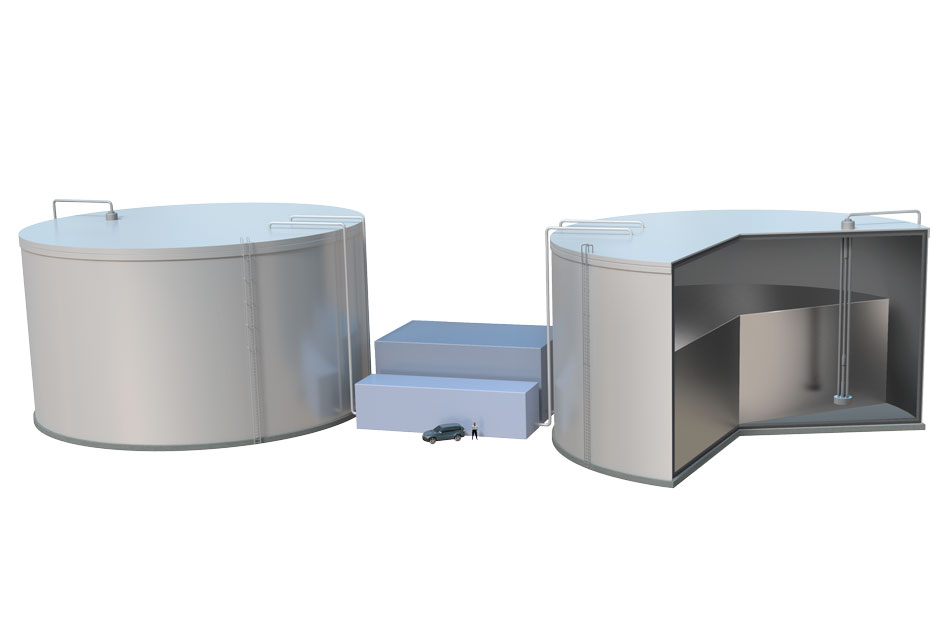A team of researchers at the Massachusetts Institute of Technology (MIT) has proposed a new energy storage concept, which they claim is far cheaper than current energy storage technologies. The MIT team points to the scalability of its so-called ‘sun in a box' concept, saying that a single large system could power a small city of 100,000 households around the clock.
The new MIT storage concept taps renewable energy to produce heat, which is then stored as white-hot molten silicon. The U.S. researchers have dubbed the technology Thermal Energy Grid Storage – Multi-Junction Photovoltaics.
The technology uses two large 10-meter wide graphite tanks, which are heavily insulated and filled with liquid silicon. One tank stores silicon at a temperature of 1926°C. The “cold” tank is connected via a bank of tubes and heating elements to a “hot” tank in which liquid silicon at a temperature of 2370°C is stored.
Excess energy from an adjacent PV system, for example, is used to generate heat, via Joule heating – a process by which an electric current passes through a heating element – to bring up the temperature of the “cold” silicon and move it to the hot tank.
When electricity is needed, the molten white-glowing liquid silicon is pumped through an array of tubes that emit light. The tubes are routed past high-efficiency solar cells, called multi-junction photovoltaics, with the light from the molten silicon then being turned back into electricity. Through that process the silicon cools down and flows back into the “cold” tank, to be used again.
“One of the affectionate names people have started calling our concept is ‘sun in a box,’ which was coined by my colleague Shannon Yee at Georgia Tech,” Asegun Henry, the Robert N. Noyce Career Development Associate Professor in the Department of Mechanical Engineering says. “It’s basically an extremely intense light source that’s all contained in a box that traps the heat.”
In the conceptual stages of the technology's development, which material to make the storage tanks out of was a concern. Potentially using graphite was thought to be a risk due to the possibility that graphite and silicon could react at these high temperatures.
When the team built a miniature tank for testing purposes, they found that while the silicon did react with the graphite to form silicon carbide, the new material stuck to the tank’s inner walls, to create a protective layer. After that thin layer was formed no further reaction occurred, proving that the use of graphite tanks is viable.
“Innovation in energy storage is having a moment right now,” says Addison Stark, Associate Director for energy innovation at the Bipartisan Policy Center, and Staff Director for the American Energy Innovation Council. “Energy technologists recognize the imperative to have low-cost, high-efficiency storage options available to balance out nondispatchable generation technologies on the grid. As such, there are many great ideas coming to the fore right now. In this case, the development of a solid-state power block coupled with incredibly high storage temperatures pushes the boundaries of what’s possible.”
In the announcement, the team of MIT disclosed that the concept was not entirely new, as others had been exploring the possibilities of storing heat from renewables. Hitherto, the focus had been to use concentrated solar power to heat metal or salt and dissipate the heat when needed to power steam engines. But this technology never managed to prompt an economically viable pricing scenario.
“This technology has been around for a while, but the thinking has been that its cost will never get low enough to compete with natural gas,” Henry says. “So there was a push to operate at much higher temperatures, so you could use a more efficient heat engine and get the cost down.”
By turning their heads to using electricity from solar PV and wind and use multi-junction photovoltaics instead of steam engines, they say the costs of stored energy could be half of that of pumped hydro – which is currently the cheapest source of stored energy.
The costs for pumped hydro storage currently are between $200/MWh to $300/MWh. Characterized by very high capacities, and extremely long lifespans of up to 80 years pumped hydro is also limited to geographical conditions, which can render prices for some facilities far higher.
This content is protected by copyright and may not be reused. If you want to cooperate with us and would like to reuse some of our content, please contact: editors@pv-magazine.com.




What are the light-emitting tubes made of? Diamond?
The scheme is macho enough to meet the demands of the critical perpetual adolescent demographic. The consequences i fit goes wrong would be interesting..
Hi James,
good question! I have compiled your question and a few of mine to send them to MIT. This is what they came back with.
MIT said that the tubes are made out of graphite. They don’t have to be transparent to emit the light, graphites black would work even better. I am assuming that as the hot silicon is flowing through the tubes they as well are heated to the point where they glow themselves.
Another reader was wondering about the size of the cell arrangement.
MIT said that because the cells are placed directly at the source of the light the energy it receives will be 500x as strong as what regular solar cells in the field receive.
On the matter which type of cells they are using, MIT said that they are working to redesign III-V multi-junction cells. Similar cells have been made before and they say that they are feeling confident about it. The CPV industry would be able to produce on a commercial scale, once they have been finally invented.
I hope this helps.
There are already molten silicon facilities being build (https://1414degrees.com.au/).
But those operate at lower temperatures and just use the heat cycle.
Why would upgrading to a way higher heat level and also using the photo voltaic in combination with heat be more efficient?
Some accounts of the system quote photo-voltaic cells, others, thermo-voltaic arrays. Whichever is used, very considerable temperatures will encountered, how is cooling achieved. No mention is made of the method of pumping.
Is not the amount of radiant energy available in accordance with the Stefan-Boltzmann law, temperature to the forth power, and thus dominated by the radiating surface area.
Richard Phillips
What’s the predicted Energy Stored on Energy Invested for this storage medium?
Could this technology be scaled down to be used in, say, an electric car in place of the battery?